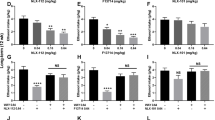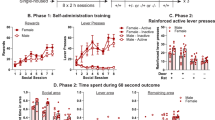Abstract
Alcohol withdrawal symptoms, particularly negative emotional states, can persist for months following the removal of alcohol. These protracted withdrawal symptoms have been implicated as an important trigger of relapse to excessive drinking in alcoholics and may represent a long lasting shift in affective tone as a result of chronic alcohol exposure. It was shown previously that ethanol-dependent rats increased their operant responding for ethanol when tested during the first 12 hr after withdrawal. The purpose of the present experiments was to determine the persistence of this finding by examining operant oral ethanol self-administration in rats with a history of physical dependence upon ethanol, detoxified and then allowed a two week period of protracted abstinence. The results of these experiments indicate that operant responding for ethanol was enhanced during protracted abstinence by 30–100% and remained elevated for 4–8 weeks post acute withdrawal. These results have important implications for understanding the characteristics and mechanisms underlying vulnerability to relapse.
Similar content being viewed by others
Log in or create a free account to read this content
Gain free access to this article, as well as selected content from this journal and more on nature.com
or
References
Ahlenius S, Engel J . (1974): Behavioral stimulation induced by ethanol withdrawal. Pharmacol Biochem Behav 2: 847–850
Ahmed SH, Koob GF . (1998): Transition from moderate to excessive drug intake: Change in hedonic set point. Science 282: 298–300
Ahmed SH, Koob GF . (1999): Long-lasting increase in the set point for cocaine self-administration after escalation in rats. Psychopharmacology 146: 303–312
U.S. Department of Health and Human Services. (1990): Seventh Special Report to the U.S. Congress on Alcohol and Health. Rockville, MD, U.S. Department of Health and Human Services.
Alling C, Balldin J, Bokström K, Gottfries CG, Karlsson I, Langström G . (1982): Studies on duration of a late recovery period after chronic abuse of ethanol: A cross-sectional study of biochemical and psychiatric indicators. Acta Psychiatry Scand 66: 384–397
Annis HM, Sklar SM, Moser AE . (1998): Gender in relation to relapse crisis situations, coping, and outcome among treated alcoholics. Addict Behav 23: 127–131
Baker TB, Cannon DS . (1979): Potentiation of ethanol withdrawal by prior dependence. Psychopharmacology 60: 105–110
Becker HC . (1994): Positive relationship between the number of prior ethanol withdrawal episodes and the severity of subsequent withdrawal seizures. Psychopharmacology 116: 26–32
Becker HC . (1999): Alcohol withdrawal: Neuroadaptation and sensitization. CNS Spectrums 4: 38–65
Becker HC, Hale RL . (1993): Repeated episodes of ethanol withdrawal potentiate the severity of subsequent withdrawal seizures: An animal model of alcohol withdrawal “kindling”. Alcohol Clin Exp Res 17: 94–98
Begleiter H . (1975): Ethanol consumption subsequent to physical dependence. Adv Exp Med Biol 59: 373–378
Begleiter H, Porjesz B . (1979): Persistence of a “subacute withdrawal syndrome” following chronic ethanol intake. Drug Alcohol Depend 4: 353–357
Booth BM, Blow FC . (1993): The kindling hypothesis: Further evidence from a U.S. national study of alcoholic men. Alcohol Alcohol 28: 593–598
Branchey M, Rauscher G, Kissin B . (1971): Modifications in the response to alcohol following the establishment of physical dependence. Psychopharmacology 22: 314–322
Brown G, Jackson A, Stephens DN . (1998): Effects of repeated withdrawal from chronic ethanol on oral self-administration of ethanol on a progressive ratio schedule. Behav Pharmacol 9: 149–161
Brown ME, Anton RF, Malcolm R, Ballenger JC . (1988): Alcohol detoxification and withdrawal seizures: Clinical support for a kindling hypothesis. Biol Psychiatry 23: 507–514
Cappell H, LeBlanc AE . (1981): Tolerance and physical dependence: Do they play a role in alcohol and drug self-administration? Res Adv Alcohol Drug Probl 6: 159–196
Denoble VJ, Begleiter H . (1978): Alcohol self-administration in monkeys (Macaca radiata): The effects of prior alcohol exposure. Pharmacol Biochem Behav 8: 391–397
De Soto CB, O'Donnell WE, Allred LJ, Lopes CE . (1985): Symptomology in alcoholics at various stages of abstinence. Alcohol Clin Exp Res 9: 505–512
De Soto CB, O'Donnell WE, De Soto JL . (1989): Long-term recovery in alcoholics. Alcohol Clin Exp Res 13: 693–697
Deutsch JA, Koopmans HS . (1973): Preference enhancement for alcohol by passive exposure. Science 179: 1242–1243
Deutsch JA, Walton NY . (1977): A rat alcoholism model in a free choice situation. Behav Biol 19: 349–360
Edwards G . (1990): Withdrawal symptoms and alcohol dependence: Fruitful mysteries. Br J Addict 85: 447–461
Files FJ, Samson HH, Denning CE, Marvin S . (1998): Comparison of alcohol-preferring and nonpreferring selectively bred rat lines. II. Operant self-administration in a continuous access situation. Alcohol Clin Exp Res 22: 2147–2158
Grant I, Reed R, Adams KM . (1987): Diagnosis of intermediate-duration and subacute organic mental disorders in abstinent alcoholics. J Clin Psychiatry 48: 319–323
Hershon HI . (1977): Alcohol withdrawal symptoms and drinking behavior. J Stud Alcohol 38: 953–971
Heyser CJ, Schulteis G, Koob GF . (1997): Increased ethanol self-administration after a period of imposed ethanol deprivation in rats trained in a limited access paradigm. Alcohol Clin Exp Res 21: 784–791
Hölter SM, Engelmann M, Kirschke C, Liebsch G, Landgraf R, Spanagel R . (1998): Long-term ethanol self-administration with repeated ethanol deprivation episodes changes ethanol drinking pattern and increases anxiety-related behavior during ethanol deprivation in rats. Behav Pharmacol 9: 41–48
Hunter BE, Walker DW, Riley JN . (1974): Dissociation between physical dependence and volitional ethanol consumption: Role of multiple withdrawal episodes. Pharmacol Biochem Behav 2: 523–529
Kalant H, LeBlanc AE, Gibbins RJ . (1971): Tolerance to and dependence on some nonopiate psychotropic drugs. Pharmacol Rev 23: 135
Kissin B . (1979): Biological investigations in alcohol research. J Stud Alcohol(Suppl) 8: 146–181
Koob GF, Le Moal M . (1997): Drug abuse: Hedonic homeostatic dysregulation. Science 278: 52–58
Koob GF, Roberts AJ, Schulteis G, Parsons LH, Heyser CJ, Hyytiä P, Merlo-Pich E, Weiss F . (1998): Neurocircuitry targets in ethanol reward and dependence. Alcohol Clin Exp Res 22: 3–9
Lechtenberg R, Worner TM . (1991): Relative kindling effect of detoxification and non-detoxification admissions in alcoholics. Alcohol Alcohol 26: 221–225
Li T-K, McBride WJ . (1995): Pharmacogenetic models of alcoholism. Clin Neurosci 3: 182–188
Macey DJ, Schulteis G, Heinrichs SC, Koob GF . (1996): Time-dependent quantifiable withdrawal from ethanol in the rat: Effect of method of dependence induction. Alcohol 13: 163–170
Meisch RA . (1983): Relationship between physical dependence on ethanol and reinforcing properties of ethanol in animals. In Cicero TJ (ed), Ethanol Tolerance and Dependence: Endocrinological Aspects, [NIAAA Research Monograph vol. 13]. Rockville, MD, National Institute on Alcohol Abuse and Alcoholism, pp 27–32
Meisch RA . (1994): Alcohol self-administration by experimental animals. Res Adv Alcohol Drug Probl 8: 23–45
Merlo-Pich E, Lorang M, Yeganeh M, Rodriguez de Fonseca F, Raber J, Koob GF, Weiss F . (1995): Increase of extracellular corticotropin-releasing factor-like immunoreactivity levels in the amygdala of awake rats during restraint stress and ethanol withdrawal as measured by microdialysis. J Neurosci 15: 5439–5447
Myers RD, Stoltman WP, Martin GE . (1972): Effects of ethanol dependence induced artificially in the Rhesus monkey on the subsequent preference for ethyl alcohol. Physiol Behav 9: 43–48
Nutt DJ, Glue P . (1990): Neuropharmacological and clinical aspects of alcohol withdrawal. Ann Med 22: 275–281
Rassnick S, Heinrichs SC, Britton KT, Koob GF . (1993): Microinjections of a corticotropin-releasing factor antagonist into the central nucleus of the amygdala reverses anxiogenic-like effects of ethanol withdrawal. Brain Res 605: 25–32
Roberts AJ, Cole M, Koob GF . (1996): Intra-amygdala muscimol decreases operant ethanol self-administration in dependent rats. Alcohol Clin Exp Res 20: 1289–1298
Roberts AJ, Koob GF . (1997): The neurobiology of addiction. Alcohol Health Res World 21: 101–106
Roberts AJ, Heyser CJ, Koob GF . (1999): Operant self-administration of sweetened versus unsweetened ethanol: Effects on blood alcohol levels. Alcohol Clin Exp Res 23: 1151–1157
Roelofs SMGJ . (1985): Hyperventilation, anxiety, craving for alcohol: a subacute alcohol withdrawal syndrome. Alcohol 2: 501–505
Rogers J, Wiener SG, Bloom FE . (1979): Long-term ethanol administration methods for rats: Advantages of inhalation over intubation of liquid diets. Behav Neural Biol 27: 466–486
Samson HH . (1986): Initiation of ethanol reinforcement using a sucrose-substitution procedure in food- and water-sated rats. Alcohol Clin Exp Res 10: 436–442
Samson HH, Falk JL . (1974): Alteration of fluid preference in ethanol-dependent animals. J Pharmacol Exp Ther 190: 365–376
Samson HH, File FJ, Denning C, Marvin S . (1998): Comparison of alcohol-preferring and nonpreferring selectively bred rat lines. I. Ethanol initiation and limited access operant self-administration. Alcohol Clin Exp Res 22: 2133–2146
Schulteis G, Hyytïa P, Heinrichs SC, Koob GF . (1996): Effects of chronic ethanol exposure on oral self-administration of ethanol or saccharin by Wistar rats. Alcohol Clin Exp Res 20: 164–171
Sinclair JD, Senter RJ . (1967): Increased preference for ethanol in rats following alcohol deprivation. Psychon Sci 8: 11–12
Spanagel R, Hölter SM, Allingham K, Landgraf R, Zieglgänsberger W . (1996): Acamprosate and alcohol. I. Effects on alcohol intake following alcohol deprivation in the rat. Eur J Pharmacol 305: 39–44
Sterling P, Eyer J . (1988): Allostasis: A new paradigm to explain arousal pathology. In Fisher S, Reason J (eds), Handbook of Life Stress, Cognition and Health, Chichester, England, John Wiley & Sons, Ltd, pp 629–649
Tabakoff B, Hoffman PL . (1992): Alcohol: Neurobiology. In Lowinson JH, Ruiz P, Millman RB (eds), Substance Abuse: A Comprehensive Textbook. Baltimore, Williams and Wilkins, pp 152–185
Winger G . (1988): Effects of ethanol withdrawal on ethanol-reinforced responding in Rhesus monkeys. Drug Alcohol Dep 22: 235–240
Acknowledgements
The authors wish to thank Tess Kimber for her technical expertise, Dr. Serge Ahmed for fruitful discussions, and Mike Arends for his expert editorial assistance. These studies were supported by National Institute of Health grants from the National Institute on Alcohol Abuse and Alcoholism (AA05457, AA06420, and AA08459). This manuscript is publication 12165-NP of The Scripps Research Institute.
Author information
Authors and Affiliations
Rights and permissions
About this article
Cite this article
Roberts, A., Heyser, C., Cole, M. et al. Excessive Ethanol Drinking Following a History of Dependence: Animal Model of Allostasis. Neuropsychopharmacol 22, 581–594 (2000). https://doi.org/10.1016/S0893-133X(99)00167-0
Received:
Revised:
Accepted:
Issue date:
DOI: https://doi.org/10.1016/S0893-133X(99)00167-0
Keywords
This article is cited by
-
Structured tracking of alcohol reinforcement (STAR) for basic and translational alcohol research
Molecular Psychiatry (2023)
-
Translational opportunities in animal and human models to study alcohol use disorder
Translational Psychiatry (2021)
-
Vulnerability factors for mephedrone-induced conditioned place preference in rats—the impact of sex differences, social-conditioning and stress
Psychopharmacology (2021)
-
Anti-relapse neurons in the infralimbic cortex of rats drive relapse-suppression by drug omission cues
Nature Communications (2019)
-
Inhibition of the rostromedial tegmental nucleus reverses alcohol withdrawal-induced anxiety-like behavior
Neuropsychopharmacology (2019)



